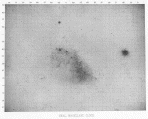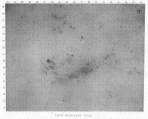Amateur Astronomer Discovers the Cepheid X Cygni and Much More!
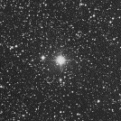 |
 |
| The Cepheid variable X Cygni and its discoverer, Seth C. Chandler, Jr. (1846-1913). |
The Cepheid, X Cygni, was first noted for its variable behavior in 1886 by the American amateur astronomer Seth C. Chandler, Jr. Chandler, a resident of Cambridge, Massachusetts, USA, had been independently monitoring the changing beacons of light in the earliest days of variable star astronomy. In fact, Chandler was observing variables 35 years before the formation of the AAVSO. Although he received no formal college training, Chandler had a natural talent for mathematics and by today's standards, was considered a human computer. In the years 1881 through 1885, Chandler worked as a volunteer observer and researcher at the Harvard College Observatory furthering his knowledge and enriching the field with his findings. Chandler was a great friend to the cause of variable star observing and encouraged others to do the same by publishing a series of articles on how to observe variable stars. Although he clearly displayed a talent for the science, Chandler opted to remain an independent amateur astronomer and continued to work his "day job" as an actuary for an insurance company.
X Cygni's discovery was announced by Chandler in the Astronomical Journal in 1886. From his first calculations, he found the star to have a magnitude range of 6.3 to 7.6 and a period of just over 14 days (Chandler 1886a), which he modified later that year to 15.6 days noting the duration of increase to be 5.6 days and that of decrease to be 10 days (Chandler 1886b). X Cygni wasn't introduced into the AAVSO visual observing program until 1931, but it has since evolved in popularity such that there are now over 14,700 observations of this star alone archived in the AAVSO International Database. Since Chandler's discovery, the magnitude range and period of X Cygni has been refined to visual magnitude 5.8 to 7.6, based on AAVSO observations, and 16.386332 days, respectively.
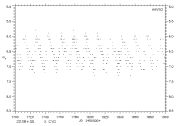 |
| 100 days of X Cyg as taken from the AAVSO International Database. Click above image for enlarged view. |
The discovery of X Cyg, however, is not one of Chandler's most noted accomplishments in astronomy, for he did so much more for the science. For instance, Chandler monitored and cataloged variable stars that he published in three early variable star catalogs, with supplements as needed. The catalogs, which contained 160 stars in the first publication and 393 stars in the last of his catalogs, contained parameters he mainly derived himself. His studies also allowed him to uncover numerous variable star relationships and led him to the independent discovery of the nova T Coronae Borealis. Also, in a time of uncertain astronomical nomenclature, he devised his own system of designation. The system, which he used in his own research, has since perished but is a testament to his ingenuity. Throughout his career Chandler published an impressive 200+ articles. Although Chandler had a close association with variable star astronomy, he is best known for his research on the variation of latitude -- the wobble of the Earth as it rotates on its axis, known as polar motion (Carter & Carter online). Chandler has undoubtedly proved what a valuable asset the amateur astronomer truly is!
Although the discovery of X Cyg came as a somewhat ordinary announcement, it is a member of the remarkable Cephied class of variable stars that have given rise to some extraordinary astronomical findings.
Cepheids: The Most Useful Stars in the Sky
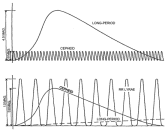 |
| Cephied light curves in comparison with their pulsating cousins, the RR Lyrae stars and long period variables. Click on the above image for an enlarged view. |
The Cepheid class of stars are said to be the brightest variable stars with 1,000 to 100,000 times brighter than the Sun. These variables are large yellow, post-main sequence stars with masses of 3-30 solar masses (Turner et al. 1999). The magnitude variations seen in Cepheids arise from pulsations that occur as periodic expansions and contractions take place of the surface layers of the star -- a result of instabilities within the atmosphere. There is evidence, however, that not all of the atmospheric layers pulsate together. It is impressive then, that the chaotic nature somehow gives rise to a light curve that is near perfect in shape and period. The distinctive shark fin-like pattern is the trademark of the Cepheid, in that the rise to maximum is usually much faster and smoother than that of the rate of decline. The amplitude of variation is generally from less than one magnitude up to 2 magnitudes, while the periods are of 1 to 135 days. These massive stars have high luminosity and are usually of F spectral class at maximum, and G to K at minimum. As with many classes of variable stars, Cepheids can be further subclassified based on various properties. For more information on the types of Cepheids, refer to the General Catalogue of Variable Stars (GCVS) for details.
Cepheids are most well known for their obedience diagramed in the famous Period-Luminosity relationship. Discovered in the early 1900s, Henrietta Swan Leavitt revealed the correlation when studying Cepheids in the Small Magellanic Cloud. When she plotted the brightness against the periods of the Cepheids she found that the longer period Cepheids are brighter than shorter period Cepheids. This finding in conjunction with other calculations proved to be a means of determining cosmic distances, not only in our galaxy but to other galaxies as well. As such, Cepheids are known for their cosmic distance ladder capablities and have been a terrific contributing factor in creating a model for the universe!
Details of this exciting and revolutionizing finding and its implications have been explored in other Cepheid VSOTM features (see Delta Cephei and Zeta Geminorum) and is a must read for those not familiar with the subject.
X Cygni's Heart Races
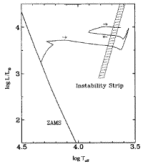 |
| The Cepheid variable goes through several passes in the instability strip as shown in Turner's 1998 paper. Click on the above image for an enlarged view. |
The regularity with which Cepheid variable light curves occur has been likened to a human heartbeat. When changes in period do occur, smooth transitions to change are generally detected. What causes a Cepheid's period to change? According to Turner et al. 1999, Cepheids enter a series of instability strip crossing modes, 5 to be exact, throughout which the stages of nuclear fuel consumption changes. These evolutionary changes are thought to give rise to the increases or decreases in period. As Turner notes, these changes are not drastic, but in extreme cases may amount to seconds or minutes per year in stars that have periods of days to months, but the effects are cumulative. X Cyg is among the Cepheids seen to undergo a period change.
 |
| The O-C plot for X Cyg, as shown in the Turner et al. 1999 paper. Click on the above image for an enlarged view. |
To detect such period changes, astronomers compare the Observed (O) and the Calculated (C) values for a star. The plots generated are referred to as O-C ("O minus C") diagrams and using such a means to test period changes is a well established tool. The diagrams produced are the O-C values plotted as a function of cycle number. If a star continually adheres to the same period, then one would expect the observed and calculated times of maximum to coincide with one another. Thus, if the plot produces a straight, horizontal line, then the period is unchanged as the observed and calculated values agree. If the O-C diagram is not a straight line, as Turner et al. (1999) found is the case with X Cyg, then the system is not completely periodic. (For more information on the different circumstances that arise in O-C diagrams and their meanings, see the section titled "O-C Diagrams" in the August 2002 VSOTM XZ Cygni.)
According to Turner et al. (1999), who claim to have performed a study of low-level sophistication, the period of X Cyg is 16.386 days and has a rate of increase of +1.460 ±0.267 seconds/year. Turner (1998) states that the majority of Cepheids with a positive change in period are in the 3rd crossing of the instability strip, as is thought to be the case with X Cyg. Monitoring this star to see how and if the period changes further is essential to the understanding of not only X Cyg itself, but contributes the pool of ideas that are used in determining and testing the theories of stellar evolution.
Get Your Student Project Here!
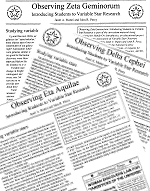 |
| The Delta Cephei or Zeta Gemiorum tutorials are available online. The Eta Aquilae, as well as the other two activities, can be requested from AAVSO Headquarters. |
Since they are commonly bright (can be observed with the unaided eye) and of short period (much less than the length of a semester), Cepheid variables are the perfect subject for students of almost any age looking to do an astronomical research project for their class. Performing a variable star study involves not only astronomy skills, but can also encompass math, physics, and computing skills. Students are encouraged by seeing real science obtained from data they retrieve themselves. Literature searches can also enhance the study and student knowledge. Not only is the science aspect of the project emphasized, but also communication and presentation skills are challenged as the student works on the preparation and presentation of the project. Outstanding high school pupils may even find that opportunities exist for the student to work directly in astronomical research with university faculty. Contact your local university to see if such an opportunity is available.
If you are looking for a place to start, the AAVSO has several Cepheid variable star observing tutorials available. Delta Cephei, Zeta Geminorum, and Eta Aquilae are a few of the popular Cepheid stars that have been the topic of such tutorials. These activities will guide you as you work on your project. For those interested in a star off the beaten track, such as X Cyg, read on. Since having a chart, or map of the sky, is key to making observations we suggest searching the AAVSO chart archives for varieties of Cepheids that may suit your needs. By using this utility, you can customize your search by magnitude range, period, and location so that you can tailor the results to match your observing needs. In addition to students, observers interested in learning about the Cepheid class of stars or those looking to add more Cepheids to their routine may find these tools to be useful resources too.
Observe X Cygni
 |
| X Cyg's location in amongst its bright stellar neighbors. Click on the above image for an enlarged view of the field. |
With a visual range of 5.8 to 7.6, X Cyg is one of the few classical Cepheids in the northern hemisphere seen to reach brighter than 7th magnitude. No large telescopes are needed to track this variable, as observers can comfortably monitor the variable throughout its range of amplitude with a pair of binoculars.
X Cyg can be found in the wing of the swan constellation of Cygnus. To assist with the identification of the variable, the AAVSO has a Cygnus constellation finder chart to get you started. You will find X Cyg about 1.7 degrees northwest of epsilon Cyg and about 1.2 degrees southwest of lambda Cyg. Once the variable is pinpointed, observers should then use the AAVSO aa-scale chart to make brightness estimates of the star as it varies through its cycle. It is recommended that Cepheids be observed every clear night and that the decimal portion of the JD is recorded to 4 decimal places. As always, submitting variable stars observations to the AAVSO is welcomed and encouraged practice.
Cepheids are an exciting class of star to ponder over, as they are an important in the study of stellar evolution and the in the distance determination of the universe. In an abstract by Wayne Lowder (1997) published in the Journal of the AAVSO he states that, "Three lessons learned in three decades of binocular observing of Cepheids are that (1) these stars are more interesting than anticipated, (2) visual observations can be very valuable, and (3) one should not give up on a star when observations seem inconsistent (example, TU Cas)." We hope that you too will find X Cyg and its Cepheid family an interesting and rewarding class of variable to observe!
For More Information
- AAVSO observing tutorials for Eta Aquilae, Delta Cephei, and Zeta Geminorum
- AAVSO VSOTM for September 2000: Delta Cephei
- AAVSO VSOTM for March 2002: Zeta Geminorum
- Carter, W.E., and M.S. Carter, "Seth Carlo Chandler, Jr.", September 16, 1846 - December 31, 1913. online article.
- Chandler, S.C., Jr. "On a New Short-Period Variable in Cygnus." Astronomical Journal, 1886a, 7, 32.
- Chandler, S.C., Jr. "Observations of X Cygni." Astronomical Journal, 1886b, 7, 159-160.
- Turner, D.G. "Monitoring the Evolution of Cepheid Variables." Journal of the AAVSO, 1998, 101-111.
- Turner, D.G., A.J. Horsford, and J.D. MacMillan. "Monitoring Cepheid Period Changes from Saint Mary's University." Journal of the AAVSO, 1999, 5-18.
This month's Variable Star of the Month was prepared by Kerri Malatesta, AAVSO Technical Assistant.


